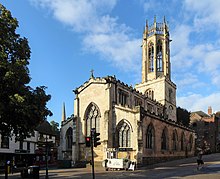All Saints' Church, Pavement, York
| All Saints’ Church, Pavement, York | |
|---|---|
 All Saints’ Church, Pavement, York | |
 | |
| 53°57′31.23″N 1°4′49.31″W / 53.9586750°N 1.0803639°W | |
| Location | York |
| Country | England |
| Denomination | Church of England |
| Churchmanship | Low church/Prayer Book |
| Website | allsaintspavement.co.uk |
| History | |
| Dedication | All Saints |
| Architecture | |
| Heritage designation | Grade I listed[1] |
| Administration | |
| Province | Province of York |
| Diocese | Diocese of York |
| Archdeaconry | York |
| Deanery | York |
| Parish | All Saints, Pavement with St Crux and St Michael Spurriergate, York |
| Clergy | |
| Priest in charge | The Reverend Liz Hassall |
All Saints’ Church, Pavement, York is a Grade I listed[1] parish church in the Church of England in York.[2] Services are from the Book of Common Prayer.
History


The church dates from the 14th century. The chancel was demolished in 1780 and the east end was rebuilt. The north wall and the west end were rebuilt in 1834.
The lantern was rebuilt in 1837.[3] The vestry was added between 1850 and 1855. The church was restored in 1887[4] by George Edmund Street when the stonework was cleaned, the pinnacles restored, and the central east window fitted with stained glass by Charles Eamer Kempe.
It was enlarged in 1912.
The church is the guild and civic church for the city of York, and the regimental church for the Royal Dragoon Guards.
In 1954 the church was united with the parish of St Saviour's Church, York when St Saviour's Church was declared redundant.
Memorials
- Sergeant Major John Polety (d. 1829)
- Charles Polety (d. 1838)
- Tate Wilkinson (d. 1803)
- Jane Wilkinson (d. 1826)
- Sir Robert Crathorn (d. 1482)
- Robert Askwith (d. 1579) (originally in St Crux's Church, York)
- Roger de Moreton (d. 1382)
- Isabella de Moreton (d. 1412) (originally in St Saviour's Church, York)
- Ursula Wyvill (d. 1790)
- Robert Bishopricke Surgeon (d. 1814)
- Henry Richards (d. 1783)
Organ
A specification of the organ can be found on the National Pipe Organ Register.[5]
Terms
The tower with the famous lantern does not fit the criteria for a lantern tower. That is tower with a special clerestory above the ceiling (or vaults) of the nave (or an aisle) which is open to the church interior below the tower, contributing to its lighting.[citation needed]
References
- ^ a b Historic England. "Church of All Saints (Grade I) (1256800)". National Heritage List for England. Retrieved 6 May 2015.
- ^ The Buildings of England. York and the East Riding. Nikolaus Pevsner and David Neave. Yale University Press. 1995. ISBN 0300095937
- ^ "All Saints' Pavement". Yorkshire Gazette. York. 29 April 1837. Retrieved 6 May 2015.
- ^ "Re-opening of All Saints' Church, York". York Herald. 16 July 1887. Retrieved 6 May 2015.
- ^ "NPOR [N04065]". National Pipe Organ Register. British Institute of Organ Studies. Retrieved 6 May 2015.
